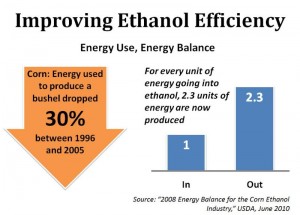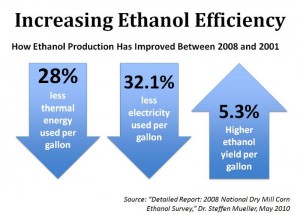This Summer Discover Ethanol
Posted: August 13, 2010

 We are officially in the dog days of summer and as such many people are vacationing and that often means lots of driving and time with family.
We are officially in the dog days of summer and as such many people are vacationing and that often means lots of driving and time with family.
With all the exposure to gas stations you may have noticed the word ethanol on pumps. It is pretty much everywhere these days as a 10% blend in gasoline and it is increasingly showing up in E85 formulations for flexible fuel vehicles or FFVs.
In fact, GM recently announced their continued commitment to E85 ethanol as “our best near-term solution. In fact, last month, we announced that we’re increasing annual production of Flex Fuel Vehicles (FFV) to more than 850,000 – that’s a 55 percent increase from the 2006 volumes,” said Candance Wheeler, a Gm Technical Fellow.
GM’s 2010 lineup represents the most FFV models on the market, providing drivers with multiple options to fuel their vehicles – E85 ethanol, petroleum, or a combination of the two. And with many new stations opening up, especially in the south and south central regions, it’s becoming easier find a place to fill up.
The latest development is something called a “Blender Pump,” but I like to call it a consumer pump because it allows you to choose what gas or ethanol mixture you want; unleaded gasoline, or 10%, 20%, 30% or 85% ethanol. If you have an FFV you can pick whichever one is the best bargain or whichever blend works best in your car.
Despite all for proven benefits of ethanol some detractors continue to spread misinformation regarding ethanol fuel. As the attached charts show, ethanol is a great fuel and an even better idea if you believe we should rely more on farmers and less on imported oil from hostile nations.




Kum Dollison Said,
August 13, 2010 @ 10:21 pm
The 2.0L TDI engine in the new Buick Regal is the game-changer, though. 5% the mileage on E85 as on gasoline, and the same in the next iteration.
This engine needs to get a LOT of Press.
Kum Dollison Said,
August 15, 2010 @ 2:07 pm
The EPA just aimed a dagger straight at the heart of the ethanol industry. As of now, those biorefiners, like Poet, Chippewa Valley, etc. that want to utilize corn cobs, wood waste, grasses, etc. are Soon to be “Shut Down.”
Currently woody biomass, generally sawdust and the residue of scrub timber, is used predominantly by sawmill operators to heat kilns where timber that is harvested for commercial wood products is dried.
“The forest products industry across the country produces between two-thirds and three-fourths of its own energy,” Jarvis said. “We’re nearly energy self-sufficient, and yet these rules would force us to stop using wood by-products for energy.”
Jarvis said if the EPA rules go into effect, saw mills would be forced to change their fuel for the kilns, generally converting to natural gas or electric. He said the conversion would be too costly for many operators and cause them to go out of business.
http://www.monewshorizon.org/story.php?title=bond-timber-industry-fight-new-epa-woody-biomass-rules-1
Make no mistake, this is Not about “sawmills,” wood stoves, etc. This is about Ethanol. And, as of right now, you’ve gone as far as you’re going. If the corn producers think this might be good for them they’re not thinking it through. If the EPA can do this, they’ll come back and get the corn guys, next. Bet on it.
mus302 Said,
August 16, 2010 @ 11:27 am
I believe that the EPA’s decision to treat carbon emissions from burning biomass the same as carbon emissions from coal shows that the modern environmental movement is less about curbing CO2 emissions and more about curbing energy use.
Brett Said,
August 17, 2010 @ 3:12 pm
You should go easy on the “misinformation” talk when you are employing it yourself. The energy used to produce a gallon of ethanol did not drop 30% from 1996-2005 — the drop is largely due to a change in the way the government does the math. The “gain” was achieved by deducting the energy used to produce DDGs from the output, so that ethanol production effectively used 30% “less” energy. This is based on the work of one scientist at USDA with whom many do not agree. In effect, we are taking cow food, processing ethanol, and ending up with ethanol and cow food. It is disingenuous to remove the DDG energy use from the equation. In fact, given that you did not *need* to do anything to corn to make it cow food in the first place, if DDGs are to be included in the equation, they should not be discounted, they should be ADDED to the total because you essentially used energy for a process that was not needed.
In any event, the point is that you can’t throw around numbers everyone agrees are slanted, and then complain about people spreading misinformation when they disagree with you.
And, frankly, enough with the “offsetting fuel from hostile nations” nonsense. American farmers in IA/MN/IL/ND/SD/WI and MN alone burn more diesel fuel annually than all of the idled biodiesel plants in the same region can produce. Yet less than 50% of farmers burn biodiesel on the farm, and over 95% of those use only a B2 or B5 blend. If the corn industry is so concerned about this, then every farmer should be burning B100 and saving us 1.6B gallons of imported fuel from the Mideast. Until they do convert, ag is second only to trucking as the biggest consumer of “terrorist produced” oil in the midwest . . .. I think many of us would be more willing to accept lectures on using E85 if it came from a farmers burning B100 themselves.